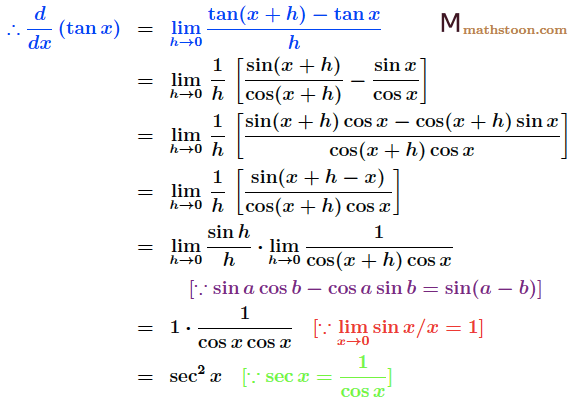The derivative (or differentiation) of tan x is sec2 x. In this post, we will learn how to find the derivative of tan x. We will use the limit definition of derivatives as well as the product or quotient rule of derivatives.
Table of Contents
What is the Derivative of tan x?
The derivative of tan x is denoted by the symbol d/dx(tan x) or (tan x)
- First principle of derivatives
- Product rule of derivatives
- Quotient rule of derivatives
- Chain rule of derivatives.
Derivative of tan x Formula
Derivative of tan x: The formula of the derivative of tan x is given below
- d/dx(tan x) = sec2 x
- (tan x)

Derivative of tan x from limit definition
Derivative of tan x by first principle. We prove that the derivative of tan x is sec2 x by limit definition. Let
Thus we have:

Derivative of tan x by Product Rule
To obtain the derivative of tan x by product rule, let us first recall that rule. For two functions f(x), g(x), the derivative of the product fg is known as the product rule of derivatives which is provided below:
Proof of the derivative of tan x is sec2 x by the product rule of derivatives: we will follow the below steps:
Step 1: At first, we express tan x as the product of two functions as follows
Step 2: Now we use the above product rule of derivatives. So we have
So the derivative of tan x is sec2 x which is obtained by the product rule of derivatives.
Also Read:
| Derivative of cotx | The derivative of cotx is -cosec2x. |
| Derivative of log2x | The derivative of log2x is 1/x. |
| Derivative of sin2x | The derivative of sin2x is 2sinx cosx. |
| Derivative of esinx | The derivative of esinx is cosx esinx. |
Derivative of tan x by Quotient Rule
Recall, the quotient rule of derivatives:
To prove the derivative of tan x is sec2 x by the quotient rule of derivatives, we need to follow the below steps.
Step 1: Express tan x as the quotient of two functions. Note that we have
Step 2: Use the above quotient rule of derivatives.
Step 3: Simplify the above expression.
So the derivative of tan x by quotient rule is equal to sec2 x.
Derivative of tan x by Chain Rule
We know that we can express tan x as 1/cot x. Using this fact we can find the derivative of tan x by the chain rule.
Let z = cot x. So we have dz/dx= -cosec2 x
∴ d/dx(tan x) = d/dx(1/cot x) = d/dx(1/z)
⇒ d/dx(tan x) = d/dx(1/z)
= d/dz(1/z) . dz/dx, by the chain rule of derivatives
= d/dz(z-1) . dz/dx
= (-z-1-1) . (-cosec2 x) by the power rule of derivatives
= 1/z2 . cosec2 x
= 1/cot2 x . cosec2 x
= (sin2 x)/(cos2 x) . 1/sin2 x
= 1/ cos2x
= sec2 x.
So the derivative of tan x by chain rule is sec2 x.
Solved Problems on Derivative of tan x
Question 1: Find the derivative of tan(x2).
Solution:
Let z =x2. Thus, dz/dx =2x.
Now the derivative of tan(x2) is
d/dx(tan x2) = d/dz(tan z) · dz/ dx = sec2z · 2x = 2x sec2(x2) as z=x2.
Answer: The derivative of tan(x2) is 2x sec2(x2).
Question 2: Find the derivative of tan x with respect to sin x.
Solution:
Let u=tan x and v=sin x. We need to find du/dv.
Now, du/dx = sec2x and dv/dx = cos x ⇒ dx/dv = 1/cos x.
So the derivative of tan x with respect to sin x is
d/d(sin x) (tan x) =du/dv
=du/dx · dx/ dv
= sec2x · 1/cos x = sec2x · sec x = sec3 x.
Answer: the derivative of tan x with respect to sin x is sec3x.
Question 3: Find the derivative of tan x with respect to cot x.
Solution:
Let u=tan x and v=cot x. Here we will find du/dv.
We have du/dx = sec2x and dv/dx = -cosec2 x ⇒ dx/dv = -sin2x.
So the derivative of tan x with respect to cot x is
d/d(cot x) (tan x) =du/dv
=du/dx · dx/dv
= sec2x · (- sin2 x) = – (sin2 x)/(cos2 x) = -tan2x.
Answer: the derivative of tan x with respect to cot x is -tan2x.
Question 4: What is the derivative of x tan x?
Solution:
By the chain rule of derivatives, we have
d/dx(x tan x) = x d/dx(tan x) + tan x d/dx(x)
= x sec2x + tan x · 1
= x sec2x + tan x
Answer: The derivative of x tan x is x sec2x + tan x.
FAQs on Derivative of tan x
Answer: The derivative of tan x is sec2x.
Ans: Note that tan2x = (tan x)2. So by the power rule and the chain rule of derivatives, the derivative of tan2x is equal to d/dx(tan2x) = 2 tan x · d/dx(tan x) = 2 tan x sec2x.
Ans: We know that the derivative of tan x is sec2x. As sec x=1/cos x, the derivative of tan x in terms of cos x is 1/cos2x.
Ans: The integration of tan x is -ln|cos x| + C (or) ln|sec x| + C.
Ans: The derivative of tan-1x is 1/(1+x2).
This article is written by Dr. T, an expert in Mathematics (PhD). On Mathstoon.com you will find Maths from very basic level to advanced level. Thanks for visiting.